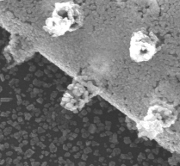Research

The NanoBio Photonics group has developed new solutions to Maxwell’s equations for subwavelength ordered structures using approximate discrete (DDA) and coupled dipole (CDA) solutions, and finite difference difference time domain (FDTD) approaches to identify near-field EM interactions responsible for photocurrent and SERS, as well as radiative far-field photon-plasmon coupling that dwarfs near-field and induction-zone interactions. Modeling these EM interactions in 2-D and 3-D structures has identified nanoscale architectures that optimize specific research objective in a variety of applications.
To fabricate envisioned nano-architectures, the NanoBio Photonics group uses conventional nano-scale fabrication techniques like electron-beam lithography, vacuum evaporation, and sputtering, and develops new ‘bottom-up’ approaches like nanosphere lithography, electroless plating, and buffered acid etching to economically create scale-able, stable gold (Au) structures. The structures exhibit extraordinary features such as photocurrent enhancement, sensor sensitivity, and thermal conductivity. Specific advances in areas of solar energy, fuel cells, point-of-care DNA analysis, and optothermal therapies for cancer have yielded improvements in (1) field sensing of chemical/biological agents; (2) optothermal properties in micro-scale opto-electronic and micro-electro-mechanical systems; (3) high-efficiency photovoltaics and fuel cell catalysis; and (4) identification of virus and DNA.

